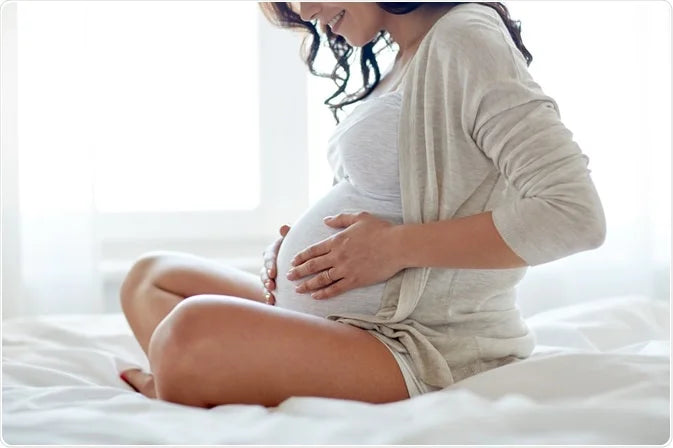Even if you might not always feel your best throughout early stages of pregnancy, feeling a new life developing inside your body is a fantastic experience. According to research one of the major changes for most pregnant people is weight gain, pregnant woman carrying one kid should gain between 11 and 40 lbs. (5 to 18 kg) by the end of the pregnancy. Pregnancy effects the body vary greatly from person to person and even from one pregnancy to the next for the same mother. While some pregnancy stages and symptoms endure for several weeks or months. Also, several obstetricians and gynecologists described pregnancy as a 10-month-long experience of ever-changing moods. If you’re new to the club and looking for information on how this natural process, we are here. Nani’s guide to 5 early stages of pregnancy is all what you need to read for a complete guidance.
About Pregnancy
Many of you might not know that, pregnancy is counted form first day of the last menstrual cycle, which is around two weeks before conception takes place. It typically lasts for 40 weeks and three trimesters of pregnancy lasts between 12 and 13 weeks. Both the developing fetus and the mothers body undergo changes during each trimester. Some medical professionals advise that mothers and doctors should also recognize a "fourth trimester," which is the 12-week period post birth during which babies are adjusting to life outside the womb and women are coping with motherhood and ongoing changes in their bodies.
Conception & implantation
Here’s where you need a little attention, because we are going to sound a little your gyno guide. Ovulation takes place about two weeks following a period, and at this time the ovaries produce usually one egg, but occasionally two or more. After 12 to 24 hours of release, the egg moves through the fallopian tube toward the uterus, a sperm cell can fertilize the egg or eggs. The sperm cell's donation of an X or Y chromosome to the egg determines the fetus's sex at the time of fertilization, also known as conception. A female will be born if the egg obtains an X chromosome, and a male will be born if the egg receives a Y chromosome.
The fertilized egg (or embryo) travels to the uterine lining over the course of three to four days before attaching or implanting to the uterine wall. After the embryo is implanted, the cells begin to multiply and eventually develop into the fetus and the placenta, a tissue structure that connects to the uterine lining. Throughout pregnancy, the placenta transfers oxygen, nutrients, and hormones from the mother's blood to the growing fetus through the umbilical cord.
First Trimester - Week 1-12
As the body adjusts to the hormonal changes of pregnancy, mother will experience a multitude of symptoms during the first trimester. Although the pregnancy cannot be showing much on the outside of her body in the early weeks, there are many changes happening on the inside.
Initially, the waves of nausea and vomiting known as morning sickness, are most prevalent during the first few months of pregnancy, may be caused by rising levels of hCG and other hormones, such as estrogen. This morning sickness named can happen at any time of day.
During the first trimester (early stage of pregnancy), a woman can also feel more exhausted than usual. This symptom is related to an increase in the hormone progesterone, which makes people feel sleepier. Another pregnancy stage and symptoms include hormonal changes, in which breasts can feel more sensitive and swollen. The skin around each nipple, known as the areolas, will color and swell. The digestive process can become slower than usual to help in better nutrient absorption. The heart is just one of the many body components that will work harder during pregnancy. The heart will beat faster in order to pump more blood to the uterus, which will then provide the fetus with it. Expecting moms can experience emotional highs and lows throughout their pregnancy in addition to the physical changes.
Moreover, around one month into a pregnancy, the embryo will be around the size of a pea, according to Burch. The embryo has expanded to the size of a kidney bean about the second month of pregnancy. In addition, the bones start to show, the genitalia and inner ear start to develop, and the ankles, wrists, fingers, and eyelids form.
Second Trimester -Weeks 13-27
As the body adapts to its fluctuating hormone levels, some of the unfavorable side effects of early pregnancy can fade or disappear by the second trimester. Energy levels could rise and sleeping could become easier. The pelvic pressure will increase in pregnant women, and the pelvis will begin to feel as though something is holding it down. As the uterus extends past the pelvis, a more noticeable baby bump develops, and the skin over the growing belly can itch as it stretches. A developing child is referred to as a fetus after the eighth week of pregnancy and up until birth.
The mother can have more back pain as the fetus grows and she puts on more weight in the front of her body. A first-time mother experiences the fetus's initial quickening, or fluttering, sometime between the 16th and 18th weeks of pregnancy. The halfway point of a pregnancy is often at week twenty. Preeclampsia, a syndrome marked by high blood pressure, can manifest starting at around 20 weeks, according to the Mayo Clinic. The disorder can cause serious, even deadly, consequences for both the mother and the infant if it is not treated. Rapid weight gain and edema are further signs.
The fetus will measure between 3 and 5 inches (7 and 12 cm) in length during the second trimester. If parents want to discover the gender of the baby ahead of time, an ultrasound between 18 and 22 weeks may do so.
The fetus's eyebrows, eyelashes, fingernails, and neck grow by the fourth month of pregnancy, and the skin begins to look wrinkled. During the fourth month, the arms and legs can flex, the kidneys begin to function and can create urine, and the fetus can swallow and hear. The fetus is more active in the fifth month of pregnancy.
Third Trimester – Week 28-40
The mother's diaphragm, a significant breathing muscle, is pressed against during the third trimester as a result of her enlarged uterus. Because the lungs have less room to expand as a result, she can experience shortness of breath. Mother’s ankles, hands, feet, and face can enlarge, due to fluid retention and sluggish blood circulation. Due to the pressure on her bladder, a pregnant woman will need to urinate more regularly. As her hips and pelvis develop in preparation for delivery, you can also experience greater backaches and hip and pelvic pain. Changes in body shape can also make a pregnant person more unsteady on their feet and more likely to fall.
As the breasts prepare for breastfeeding during the third trimester, they begin to leak colostrum, a yellow liquid. When the due date is near, infant will begin to move down in the mother's belly. As parents labor to baby-proof their home, shop for baby supplies, prepare the nursery, and wait for their new arrival, a "nesting urge," behavior displayed by many. In the ninth month the fetus begins to turn into a head-down position in the mother's pelvis in preparation for delivery. The lungs are now fully developed and prepared for independent operation. A baby is considered to be fully-term when it is born between 39 and 40 weeks into the pregnancy.
Fourth Trimester- Post Birth
When the fourth trimester begins majority of new parents, this can be a happy and exciting moment, but it can also be incredibly difficult and stressful. The mother's body undergoes significant changes as it heals and recovers from pregnancy and delivery in the weeks and months following the birth of the child. Women and their families go through significant physical, social, and emotional changes during this time.
Even though there are several stages to pregnancy, it is a wonderful experience and is no less than a blessing. Early stages of pregnancy can have various physical, hormonal, and emotional changes which is a lovely period. To maintain her health and happiness, every woman should be aware of how pregnancy stages and symptoms starts, develops, and ends. Nani Guides you great detail on the different phases of pregnancy in this piece. We also explain to you the changes you might experience and the development of the fetus. For more information related to phases of motherhood, hop on to our blog now.
Early stages of pregnancy
Pregnancy stages and symptoms









